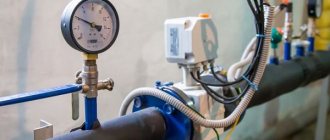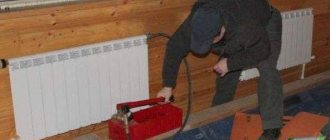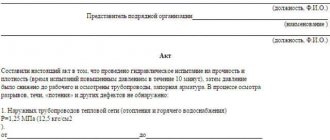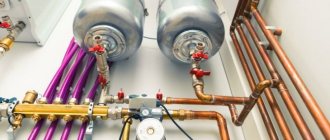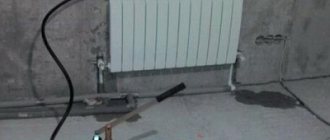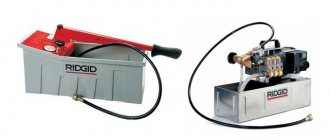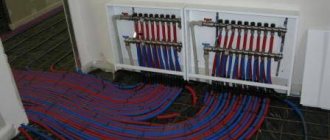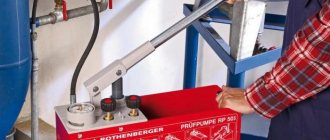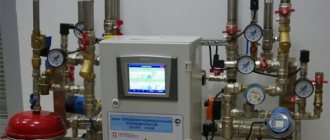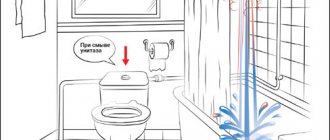Pressure testing is a hydraulic or pneumatic test for the strength and tightness of pipelines and other equipment operating under pressure. A pressure is created in the system one and a half or two times higher than the working one and maintained for some time. If the pressure does not drop, the system is considered sealed and suitable for further use.
Hydraulic testing of water supply pipelines usually becomes the next step after completion of installation work. This stage cannot be avoided when working with networks that operate under pressure.
When performing this procedure, a pump is used to build up pressure. This contributes to the timely detection of defects.
After conducting a hydraulic test of the pipeline, they proceed to drawing up a report. Only after its signing the operation of the pipeline becomes available.
The procedure for testing water supply pipelines and its purpose
Hydraulic testing is a type of non-destructive testing that is performed to test the strength and tightness of pressure piping systems. Scan parameters are calculated for each system separately depending on its type
When testing water supply pipelines, experts check several indicators at once:
- Detection of defective areas.
- Tightness.
- Reliability.
Heating testing is carried out before a newly built facility is put into operation. This applies not only to the introduction of new communications, but also to its overhaul.
If defects are found, they are eliminated as soon as possible. The tests are repeated until the results are found positive.
The pipeline tests themselves are carried out in two passes.
- First come the preliminary ones.
- These are followed by the final ones.
The first stage involves pumping water into the pipeline under high pressure. The main thing is that the pressure is one and a half times greater than normal operating indicators.
At the same time, it is important to maintain access to system elements that are located both inside and outside. This must be done before plumbing fixtures are installed.
IMPORTANT! Hydraulic testing of water supply pipelines is also prescribed before finishing the interior. Specially trained people are responsible for hydraulic testing of water supply systems.
The underground sections of the pipeline are completely closed before final testing begins. At this stage, it is necessary to complete all installation work.
But the installation of plumbing fixtures has not yet begun. During these activities, the pressure is increased by 1.3 times compared to normal.
The technique allows for additional rules.
- Hydraulic checks of water supply systems should be carried out only 24 hours after installation is completed. The ambient temperature must be above zero.
- During this event, the pipes are completely filled with water. Until it reaches the top of the risers. Before this, the condition of the pipes undergoes a visual inspection to control. If noticeable deficiencies are identified, they are corrected immediately. The system is considered to have successfully passed the test if no leaks occur within 20 minutes of operating condition. And if the water maintains the previously noted level.
What testing tool is needed?
Now let's talk about what crimping equipment is used during the work. To perform hydraulic tests, you need to use specially designed pumps (they are called pressure testers). You can find two modifications - electric and manual.
Hand pumps are a cuvette in the shape of a rectangle; water is poured into it, which is then pumped into the heating system. A plunger-type pump is placed on its side, with a handle on top of it. It is with its help that the pump plunger is driven. There are pressure gauges on the body, with their help the pressure of the liquid pumped into the system is controlled. One shut-off valve allows water to be shut off after pumping into the pipes is completed. The second valve allows liquid to be drained from the tank.
Plunger pumps operate on the same principle as simple piston pumps, which are used to inflate bicycle or car inner tubes. But there is also a difference - the plunger pump design has a cylindrical steel piston that moves in the housing with minimal clearance. It is with this that it is possible to pump liquid into the heating system at a pressure of up to 60 bar.
The main disadvantage of manual mechanisms is that it takes a long time to carry out crimping work. Moreover, the test time depends on the length of the heating circuits. Sometimes it takes several hours to completely fill. Imagine how much strength you will expend to pull the handle.
It is with the aim of reducing costs and automating the process that electric pumps are used by specialists. They work on the same principle as manual ones, only muscle power is replaced by an electric drive. Automatic systems are good because you can set the required level of discharge pressure. Once it is reached, all equipment is turned off.
Automatic devices can pump liquid at a pressure of 40-100 bar. But there are also industrial designs that are capable of creating pressure up to 1000 bar.
Please note that the Ministry of Energy sets requirements according to which it is necessary to use only spring-type pressure gauges for control; their accuracy class must be 1.5. The circumference of the housing must be more than 160 mm. The scale must be designed to measure pressure, the value of which is at least 4/3 of the minimum, the division value is less than 0.1 bar.
Under what conditions is it necessary to carry out hydraulic testing of pipelines?
It is necessary to realize how complex the hydraulic testing of plumbing systems is. The reliability of the structure itself and its quality largely depend on the competence of this procedure. Therefore, the work is trusted only to specialists with the appropriate classification.
The requirements for the test work itself include several items. This is required by any technique.
- All points of use in the riser are switched on simultaneously to check efficiency. But the need at this stage is determined individually, at each enterprise separately.
- The condition of heated towel rails is tested when the hot water supply is checked.
- Temperature measurements take place only at the extreme sections of the system. Water is poured with predetermined characteristics.
- The liquid must be completely drained after completion of all stages of the activity.
- Filling of pipelines begins from the lower floors, gradually moving to the upper ones. Then the air will be properly forced out of the pipes. And there is no danger of air pockets appearing in the pipeline.
- The first stage in filling the water pipeline affects only the main section. Only at the next stages they move on to small local networks and individual risers.
- Outdoors or indoors during work the temperature should not fall below +5 degrees.
Crimping procedure
To check the heating system in this way, hydraulic tests are carried out on the following elements:
- Pipes.
- Heat exchangers.
- Boilers.
If leaks are detected during testing, a conclusion is made about the depressurization of the network.
Immediately before testing, the water supply and heat supply systems are isolated. They also visually determine the strength of the existing connections, check the shut-off valves for operability and evaluate their general condition.
At the next stage, the expansion tank and heating boiler are turned off in order to flush heating devices and pipes from deposits of various natures and remove debris and dust.
If hydraulic tests involve filling the heating system with water, then a compressor is connected to the drain valve to test with air. Gradually, the pressure in the system increases, its indicators are monitored on special pressure gauges. If there are no changes, a conclusion is given about the good tightness of the system and the possibility of putting it into operation. Pressure testing of heated floors with air is carried out in a similar way, including some nuances.
If an acceptable pressure drop is observed during pressure testing of the heating system, then there are areas with defects in the system. During hydraulic tests, such places leak. If the test was carried out with air under pressure, then the joints and joints are treated with a soap solution.
Pressure testing with air lasts approximately 20 hours, hydraulic tests require only 1 hour.
If defects are detected, repair work is carried out and pressure testing is carried out again. The steps are repeated until good tightness of the system is achieved. Based on the results of the work carried out, a pressure test report for the heating system is drawn up. It is worth noting that the heating system pressure test certificate is a necessary document.
It should be remembered that in most cases the test is carried out hydraulically. Air tests are carried out when it is impossible to fill the circuit with water or at low air temperatures when the liquid simply solidifies.
Carrying out the procedure at the preliminary stage
Video: hydraulic testing of water supply and heating
Testing of heating and water supply systems
Building codes govern the order in which inspections are carried out.
- First, the water supply is filled with liquid. And leave it in this state for two hours.
- They proceed to create increased pressure for two hours. It happens very slowly. At this stage, it is already possible to identify a number of leaks.
- The pressure is reduced until they reach the calculated values. Then they move on to examining the general condition of the route.
- This pressure is maintained for thirty minutes or more. Without such a step, the deformed shape of the pipes simply cannot be stabilized.
- The next stage is turning off the taps at the entrances. The water is slowly drained using a pressure test pump.
- The route is checked for serious problems, as well as the density and strength of all sections.
IMPORTANT! It is better to find out in advance what pressure is standard for a particular line, according to SNiP. This will allow you to compare the readings with the limits shown on the devices themselves. And follow the method exactly.
Requirements for crimp testing
A heating system inspection can only be considered completed if certain requirements are met:
- All tests are carried out under the strict supervision of the shift supervisor.
- During control activities, it is prohibited to perform any work at the site.
- The testing program must be approved by the chief engineer of the testing organization. The program strictly regulates the actions of each employee and the sequence of the technological process. In addition, it outlines safety measures when carrying out inspection activities and scheduled work at adjacent facilities.
- The presence of strangers at the site during pressure testing of the heating system is not allowed. Only specialists directly involved in the inspection should be on site.
- It is prohibited to enable or disable the object being checked.
- During testing, adjacent areas must be fenced off with special structures, and the testing equipment must be turned off.
- During the inspection of the equipment being tested, the operating pressure must be maintained in the system; exceeding these values is not allowed.
- To confirm the tightness of the water heating system, the responsible specialist draws up a report on the performance of pressure testing.
What is the final hydraulic test of water supply lines?
Such hydraulic checks of water supply pipelines are carried out after the installation of plumbing fixtures for hot water is completed.
- They start by pumping up the working pressure in the water supply. It must be raised to the initial level if the indicator has dropped by 0.02 MPa.
- The pressure rises ten minutes before the test readings. The system remains in this state for two hours.
Pressure testing with air and water - what is it?
The essence of pressure testing is to fill a certain system with a closed volume - a pipeline, container, machine or mechanism - or its isolated section with a medium whose pressure is 2 - 3 times higher than the working one and almost corresponds to the maximum permissible value (the value of the test pressure for each specific case is set by the appropriate norms).
If the object passes this test, it is considered suitable for use.
Otherwise, places where the system has leaked are identified and repaired.
To create the required pressure, either a special pump for pressure testing pipelines, the so-called pressure tester, or a standard one, for example, a circulation pump in a centralized heating system, is used.
Water is usually used as a working medium, but if for one reason or another its penetration outside the tested system is unacceptable, pressure testing is carried out with air. In this case, leak locations are more difficult to detect.
Pressure testing is a fairly serious undertaking and must be carried out by a specially trained, certified employee. For municipal and industrial enterprises this rule is mandatory.
Upon completion of the procedure, a Certificate of hydropneumatic testing of the system (pressure testing of the pipeline) is signed, indicating the date, pressure value, holding time and other information.
As for private housing, the decision here is in the hands of the homeowner. Many people undertake crimping on their own, but it is still better to entrust this work to a professional.
Equipment washing
It is organized before the water fittings are installed. And here it is assumed that the pipeline is completely filled with water. Next, follow the following sequence of actions.
- Shut off the valve that connects the hot water supply system to external networks.
- Hoses for discharging contaminated water into the sewer system are connected to drain valves responsible for emptying the risers.
But even after such washing there is no guarantee that all debris will be removed. Therefore, specialists are developing equipment that increases the effectiveness of this process.
Video: What is pressure testing of a heating system
What is pressure testing of a heating system?
Any similar device creates a mixture of air and hot water, which is impulsively supplied into the pipeline, which requires cleaning. When the mixture passes through the equipment, it is discharged into the sewer system. The pulsation or feed force can be easily adjusted by lengthening or shortening the time intervals.
Permissible pressure standards when performing pressure testing work
When performing hydraulic pressure testing of a heating system, it is important to comply with the requirements of SNIP regarding test pressure. In particular, the document says that the test pressure should exceed the operating values by approximately 1.5 times, but not less than 0.6 MPa.
According to another document, “Rules for the technical operation of thermal power plants,” the pressure can exceed the permissible standards by 1.25 times.
Autonomous heating in private houses does not exceed 2 atmospheres, otherwise the pressure relief valve is triggered.
About special equipment for crimping
The design of the injection mechanism is the main difference between pump models, without which hydraulic testing of water supply lines in accordance with SNiP becomes impossible.
This feature allows us to divide into the following groups:
- Membrane.
- Vane-rotor.
- Piston.
A manual pressure tester is the cheapest option, suitable for heating and water supply circuits in private homes. The operator, using this device, can pump up to three liters of liquid per minute into the system.
If the house is multi-story, it is recommended to give preference to options for devices with an internal combustion engine drive or an electric version.
Two-stage pumps allow you to solve more serious problems. The methodology of their work remains approximately the same.
About regulation and other features of the process
SNiPs contain all the information related to inspections for both internal and external networks. Industry standards describe the methodology for conducting events at enterprises in a specific field of activity.
SNiPs also show what the test pressure should be. You can download SNiP 3.05.04-85 here snip_3_05_04_85. This indicator depends on several factors:
- The height difference between elements located above and below.
- The thickness of the walls.
- The material from which the pipeline is made.
Video: hydraulic test of heating pipelines
Hydraulic testing of heating networks
The pressure value according to SNiP usually does not exceed 10 MPa. A specific indicator is individually calculated for each type of pipeline, for certain types of hydraulic tests of water supply systems.
How is the work results report filled out?
The document must display information related to:
- Signs of a violation of tightness, reliability in threaded and welded connections, if present. Have drops appeared on the surfaces of pipes and fittings?
- The results of direct verification.
- Methods for eliminating identified faults.
- Address and date of inspection. And the names of the citizens who signed the act. Typically, signatures are provided by the owners of houses or apartments. Or this function is assigned to representatives of the repair and maintenance organization.
- The project in accordance with which the circuit was installed.
- The crimping method used in practice.
About pressure standards for crimping
When testing water supply, the pressure indicator according to SNiP depends on what indicator is considered working for a particular system. In turn, the base materials in the pipes determine the value of the operating pressure itself.
No less attention is paid to radiators used during installation work. When pressure testing is carried out in new systems, the pressure indicator according to GOST is two times higher than the working norm. For existing systems, an excess of 20-50 percent is acceptable.
Each type of pipe and radiator can withstand a certain maximum pressure. This factor must be taken into account when choosing the optimal performance indicator for a particular system. And when choosing the parameters on which crimping is carried out.
At the input unit, crimping deserves special attention. The minimum required level for such work is 10 atm.
Without special electric pumps, creating a parameter of this type is impossible. The result is considered positive if the parameter drops by no more than 0.1 atm in half an hour.
Private houses: we carry out pressure testing
Private houses require the use of closed water supply systems. According to GOST, the maximum operating pressure for them is 2 atmospheres.
When conducting hydraulic tests, you cannot do without pumps with manual and electric drives, which help build up pressure to 4 atmospheres. Connection to the heating main is acceptable.
Video: hydraulic test of cold water supply systems
Pipeline testing in cold water (50 atm).MOV
Water begins to fill the structure from below, using a drain tap. Next comes the air, it easily pushes out the water. Excess is removed through air-type valves mounted at the very top. The same thing happens on every radiator. Or in places where air traffic jams appear.
To test water supply communications, use water whose temperature does not exceed 45 degrees according to GOST.
Carrying out pressure testing yourself is mandatory if the owner installs the entire pipeline system himself. The procedure is the same as in houses with many apartments.
The level of water hardness for hydraulic testing of water supply pipelines must remain low if it is then planned to be used as a coolant.
It is permissible to use melt or rain water. It is completely drained if no further use is planned.
Diagnostic methods
In total, according to SNIP-41-01-2003, two methods can be distinguished by which it is allowed to test the heating system:
- Water testing is the main method by which all circuits are tested. In this case, water should be pumped into the lower part of the pipes through a tap. It is possible to pump liquid using both automatic and manual pressure testing pumps. The advantage of this method is that it is very simple to complete all the work, and the efficiency of leak detection is high. The fact is that traces of liquid will immediately appear on the pipes.
- Testing with air is not a very effective method, since it is quite difficult to detect leaks. But it is permissible to use this technique at subzero temperatures – the air will not freeze. A compressor is used to force air into the system. It is connected using an adapter to the pipeline. In order to find the leak, you need to listen. Once you find the approximate location of the leak, use a soap solution.
How it's done?
The general scheme of hydropneumatic tests is as follows:
- The part of the system being tested is isolated by shutting off the shut-off or control valves (the sewer pipes are closed with rubber plugs or wooden plugs wrapped in rags).
- Next, the system is completely filled with water. In the heating system, air is released through air vents installed at the very top.
- A pressure testing pump is connected to the pipeline, which pumps a certain amount of working fluid into the system, creating the pressure required by the test regulations.
- When the required pressure is reached, the pressure tester switches off. In this case, the observer records the readings on the pressure gauge.
- The system remains under pressure for a certain period of time. The exposure time can range from 0.5 hours (for heating systems) to 6 – 8 hours.
- After the appointed time has expired, the observer takes readings from the pressure gauge again. If the pressure differs from the original value, then there is a leak in the system that should be found and repaired. After this, crimping is performed again.
Pressure testing of heating system with air
The following connection points are usually used:
- For heating systems: a special valve on one of the radiators, or a drain valve on the elevator unit (in centralized systems).
- For water supply systems: one of the connections to a cold or hot water tap.
- For the sewerage system: any of the revisions, usually installed in increments of 40 - 50 m.
If the heating system has been tested, the Hydropneumatic Test Report is signed by representatives of the heating network and the organization providing heat supply. Next, the inspector checks the coolant for hardness.
Pressure testing of individual heating points in the Perm region
It must be remembered that hydraulic testing of ITP is a rather complex multi-stage procedure, and not all contracting organizations in the Perm Territory have the technical capabilities to carry it out at a high level. Our company has extensive practical experience in crimping Perm individual heating points, as well as a thorough understanding of all the nuances of this type of work. Having all the capabilities (experienced personnel, professional equipment, precise control equipment), we are ready to offer the best prices for crimping work and ITP maintenance. Region – Perm and Perm region.
Are you interested in professional crimping of ITP (Perm region)? You can ask questions, calculate prices or place an order directly on the website or by calling the specified phone numbers.
What is pressure testing of a heating system - description of the process, sequence of work
Hydraulic tests of heat supply systems are usually carried out with different pressure tests depending on the purpose of the system and the type of equipment used.
For example, a heat input unit into a building is pressurized with a pressure of 16 atmospheres, heat supply systems for ventilation and ITP, as well as heating systems for multi-storey buildings - with a pressure of 10 atmospheres, and heating systems for individual houses - with a pressure from 2 to 6 atm.
Heating systems of newly constructed buildings are pressed with 1.5-2 times greater pressure from the worker, and heating systems of old and dilapidated houses are pressed with lower values in the range of 1.15-1.5. In addition, when crimping systems with cast iron radiators, the pressure range should not exceed 6 atm, but with installed convectors - about 10.
Thus, when choosing pressure testing, you should carefully read the equipment data sheets. It should not be higher than the maximum pressure of the “weakest” link in the system.
First, the heating or heat supply system is filled with water. If the heating system is filled with a low-freezing coolant, then pressure testing is carried out first with water, then with a solution with additives.
You should know that due to lower surface tension, coolants based on ethylene glycol or propylene glycol are more fluid than water, so in case of minor leaks on the threaded connections, sometimes they should only be tightened slightly.
When preparing a functioning heating system for the heating season, the working coolant must be drained and refilled with clean water for pressure testing. The heating system is usually filled at the lowest point of the boiler room or heating unit through a drain ball valve.
In parallel with filling the heating system, air must be bleed through air vents on risers, the top points of branches or through Mayevsky taps on radiators. To prevent airing of the heating system, the system is filled only from the bottom up.
Then the system pressure is increased to the calculated one, with the pressure drop monitored by measuring pressure gauges.
In parallel with pressure monitoring, a visual inspection of the entire system, pipeline assemblies, threaded connections and equipment is carried out for the formation of leaks and the appearance of drops on the seams.
If condensation forms on the system after filling with water, the pipelines must be dried and then inspected further.
Heating devices and pipeline sections hidden in building structures are subject to mandatory inspection.
The heating system is kept under pressure for at least 30 minutes, and if no leaks are detected and no pressure drop is recorded, then it is considered that the system has passed pressure testing.
In some cases, the pressure drop is permissible, but within limits not exceeding 0.1 atmospheres, and provided that a visual inspection does not confirm the formation of water leaks and violations of the tightness of welded and threaded connections.
If the result of hydraulic tests is negative, repair work is carried out with further repeated pressure testing.
Upon completion of the testing work, a test certificate is drawn up in the form specified in the main regulatory documents.
Price
The cost of crimping depends on several factors:
- length (internal volume) of the system;
- the age of the system and the condition of its constituent elements (amount of rust and dirt and salt deposits);
- type of equipment used.
Prices from different performers, even within the same city, may differ by 2–3 times. Private teams and craftsmen charge the cheapest for their services.
On average, for flushing and pressure testing the heating system of a building with an area of 400 sq. m (two-story) performers charge from 7 to 15 thousand rubles. As practice has shown, if you know how to bargain, you can agree to complete this amount of work for 4–5 thousand rubles. The work will be completed in 1 – 2 days.
The same work in a building of 5 thousand square meters. m (5 floors) will cost from 30 to 80 thousand rubles.
Some performers indicate prices per unit of volume (150 - 250 rubles / cubic meter) or time (500 - 1000 rubles / hour).
If you want to install the washbasin yourself, be sure to take care of connecting the water seal. Water seal for sewerage: types, purpose and installation features.
You will learn about the types of antiseptics for cesspools in this review.
When is pressure testing of pipelines carried out?
All new pipeline systems, tanks, etc. are subject to pressure testing before putting into operation. All objects that have undergone repair or replacement of some element are also checked. Since the joints with installed fittings are considered to be the most unreliable sections of the pipeline, sections where coupling was used are subject to mandatory inspection.
All types of pipelines, domestic and industrial, newly built and already in operation are subject to pressure testing
Testing is also carried out in other cases:
- if the pipeline has been idle for a long time or operates in seasonal mode (like a heating system in the summer);
- if scheduled inspections are provided. In this way, the polymer sewer system is checked when the integrity of the outlet pipeline is monitored. Pressure testing of a plastic water supply is one of the most popular operations carried out after any pipe cleaning, since mechanical damage is very likely, especially at the joints;
- after flushing the pipeline, especially with the use of aggressive chemicals, which could cause damage to fittings or pipe walls;
- Wells are tested in a special way - to check whether perched water (water from the surface layers) gets into its shaft, because consumers are concerned about the quality of water, especially drinking water.
Pressure testing of the heating system - the most complete information
The heating system in private houses differs significantly from city apartments due to its complexity; it may contain several circuits of heated floors and heat exchange radiators with a large number of connections. After installation, a performance test procedure is mandatory; for this test, a technique called pressure testing of the heating system is used.
To carry out crimping work, special automatic or manual equipment is used; if it is available, the test will not cause any particular difficulties even for an unprepared homeowner. The only thing you should know when pumping water or air into the system is the pressure limits and time intervals for checking a specific heating network, which are specified in the regulations.
Fig.1 Hydraulic test process in the basement of a building
What is pressure testing of a heating system?
It is not difficult to understand why pressure testing of the heating system is necessary, using simple logical reasoning - after installing the circuit by specialists, it must be checked for functionality before the final payment for the work performed.
Pressure testing is the testing of a heating system by injection of water or air into it for a certain time under pressure exceeding the working pressure by 1.5 - 2 times. In private homes, the circuits of heat exchange radiators and heated floors, collectors and shut-off valves, joints between appliances and pipes, electric circulation pumps, heating boilers and boilers are checked.
This method determines the ability of equipment materials and heating pipes to withstand high pressure, as well as the tightness of all butt joints - a positive test result means the heating system is ready for long-term operation in trouble-free mode.
Rice. 2 How to install a flushing compressor for cleaning pipes
When is heating pressure tested?
Tests for “strength and density” in accordance with the Technical Operation Rules (RTE) of thermal power plants from the Russian Ministry of Energy (clause 9.2.12) are carried out in the following cases:
- Primary. In cottage-type houses, the system is tested after installation before putting it into operation; diagnostic work is carried out before sealing pipelines into grooves and pouring heated floors. It should be noted that it is possible to re-hydrotest the heating circuits after sealing all pipelines in the walls and screed - this will save expensive finishing materials when leaks are detected.
- Periodic. Hydrotests are carried out annually at the end of the heating season; their purpose is preliminary preparation for operation of heating networks in the event of their unplanned connection to operation. Before the start of each heating season, a repeated hydraulic check of heating systems is carried out.
- Extraordinary. After repairs, before starting up after a long period of inactivity with draining of the coolant, the system needs to be hydrotested for tightness and strength.
It is clear that in all of the above cases, pressure testing is a diagnostic tool that allows you to identify in advance problem areas and equipment that can lead to coolant leakage - which means repairs and lack of heating of the house in cold weather.
Rice. 3 Example of installation of heating systems with a water-heated floor circuit
Norms and rules for testing
Pressure testing of the heating system is carried out at positive ambient temperatures; testing when the thermometer readings are below zero is allowed only in emergency situations; inside buildings the temperature should not drop below +5 C. The system successfully passes hydraulic tests if:
- No fogging of welding seams, no leaks in heat exchange radiators, boilers, pipes, fittings and other heating equipment were detected.
- The pressure drop in the heating circuit did not exceed 0.2 bar in 5 minutes.
- In panel heating, the pressure drop according to the control pressure gauge in a 15-minute time interval did not exceed 0.1 bar.
- In hot water supply systems (DHW) with metal pipes, the permissible pressure drop did not exceed 0.5 bar. in a 10 minute interval.
- For plastic pipes, the permissible pressure drop was no more than 0.6 bar in the first 30 minutes from the start of hydrotesting; during a subsequent 2-hour test, the pressure drop did not exceed 0.2 bar.
- During air tests of steam and panel heating, the pressure drop did not exceed 0.1 bar. in the first 5 minutes.
Rice. 4 Pressure testing in a private country house
How to pressurize a heating system
There are two main methods of pressure testing of systems:
- Pressure testing with water. The main method for testing heat-transfer circuits, water is pumped into the lower part of the pipeline through the shut-off valve of the drain pipe using an automatic or manual pressure test pump. The advantage of the method is the ease of detecting leaks using water prints.
- Air pressure testing. Not a very effective method due to the difficulty of detecting leaks, it can be used to check the heating circuit in the cold season, when the use of water is difficult due to the possibility of freezing. To pump air, a compressor is used, which is connected to the pipeline through a special adapter. To detect the location of a leak, auditory methods are used; to accurately localize the air-permeable connection, a soap solution is used, similar to checking gas pipes.
Rice. 5 Pressure testing of pipes with a special flushing compressor
Test pressure
The rules for pressure testing of heating systems are regulated by the PTE for heating installations from the Ministry of Energy (clause 9.2.13) in force since October 1, 2003, according to them the test pressure in an apartment building should not be less than:
- 1 mPa (10 bar, atm.) in home hot water supply and heating systems with water heaters;
- 10 bar (atm.) for panel and convector heating circuits;
- 6 bar (atm.) in a circuit with radiators made of cast iron or stamped steel;
- pressure equal to the working pressure with the addition of 5 bar (atm.) but not more than 10 bar for hot water supply;
- pressure, which must exceed the operating pressure (set by the manufacturer and indicated in the technical parameters of the devices) by 1.5 - 2 times for heating air heaters and heating ventilation.
For panel heating in conjunction with heat exchange devices, the test pressure cannot exceed the tolerances for these devices.
If pneumatic tests are carried out with air in panel and steam heating, the pipes to the ventilation equipment are checked, the air pressure is 1 bar.
Work order
The PTE of heating installations regulates the procedure for conducting hydrotests in the following sequence:
- The heat-conducting circuit is filled with water by a pressure tester at a temperature of about 45 degrees, and air is released through air vents.
- Water is injected at operating pressure for at least 10 minutes - during this time interval, all welded and flanged joints of pipes, fittings and connected equipment are visually inspected.
- Next, the pressure is brought to the test pressure and held for 10 minutes; for pipes made of polymers, the test time is at least 30 minutes.
- If during this time interval the pressure has not changed, and accordingly no defective areas have been identified that should leak, the tests are considered completed.
Rice. 6 Manual crimping units
Tool used
During hydraulic tests, special injection pumps (pressure testers) are used, which are produced by industry in two modifications - manual and electric devices.
A manual hydraulic pump is a rectangular cuvette into which the liquid pumped into the system is poured; a plunger pump with an upper handle is installed on the side, driving it.
The presence of taps and pressure gauges on the body is necessary to control the discharge pressure and shut off the water.
One of the shut-off valves cuts off water after pumping into the pipeline, and the second serves to drain liquid from the device tank.
The operating principle of plunger pumps is similar to conventional piston pumps used to inflate car and bicycle tires, the main difference being the presence of a steel cylindrical piston that moves in a tightly fitted housing with minimal clearances. Thanks to this, a manual plunger pump can be used to pump liquid into the heating circuit at a pressure of up to 60 bar.
The main disadvantage of manual devices is the long pressurization time with a long heating line - if private houses contain several underfloor heating circuits and heating radiators, filling them can take several hours (not counting the significant energy costs when applying physical effort while pumping water) .
Rice. 7 Automatic pressure testing pumps
Therefore, specialists professionally involved in the installation of heating systems use electrical devices that operate on a similar principle. Automation is also convenient in that you can set a limit for the pressure pumped into the system; when it is reached, the electronics will automatically turn off the pressure crimper.
Electric models for professional pressure testing are capable of pumping water under pressure from 40 to 100 atmospheres; industrial pressure testing stations can supply liquid under pressure up to 1000 atmospheres.
Standards from the Ministry of Energy establish the requirements that pressure gauges used for control must meet: spring models with an accuracy class of at least 1.5 and a body circumference of 160 mm or more are allowed. The measuring scale should be designed to measure pressure about 4/3 of the nominal pressure with divisions of no more than 0.01 mPa. (0.1 atm., bar.)
Types of testing and crimping of the system
The above standards of the Ministry of Energy on the frequency and testing regimes of heating systems are mandatory for government organizations and public utilities; in private homes, their compliance is by no means mandatory. Pressure testing is always carried out after delivery of the system to the customer before its operation; further inspection is usually carried out no more than once every 5 years.
To carry out testing work, no special skills or knowledge are required, so any owner can do it independently. To do this, there is no point in buying a manual or electric crimping unit (the lowest price for manual devices is about 100 USD), you can rent an electronic device and carry out the tests yourself within a couple of hours.
If there is no desire to carry out the tests yourself and financial resources allow, an official certificate of the work performed is required; a specialized company will help you do the crimping; the services of its specialists will cost an hourly rate of 1000 to 2500 rubles per hour.
Rice. 8 Testing the system in an apartment building
Pressure testing in an apartment building
Pressure testing of the heating system of an apartment building is carried out to find faults and leaks in fittings and pipes at the end of seasonal heating (from mid-April to May).
If there are complaints from residents about the low heating temperature in their apartments, the radiators are first calculated with their further replacement or installation of additional sections if necessary. All risers are also checked for blockages and pressure flushing of the problematic riser and radiators of the heat exchangers of individual apartments or the entire circuit is carried out.
The following preparatory work is also carried out:
- The shut-off valves in elevators, on central line pipes and risers are inspected. On cast iron valves, the seals in the form of sealing cords are replaced, new paronite gaskets are installed between the flange connections, and stuck bolts are replaced. Other pressure gauges are installed in the elevator units and the old ones are sent for testing; the oil level is monitored in thermometers.
- Pipes and fittings are visually inspected for defective areas, corrosion damage, fistulas, and if problem areas are detected, they are repaired.
- The condition of the thermal insulation of the basement main and risers going to the floors is checked.
Next, pressure testing procedures begin, the system is tested taking into account the technical parameters of the radiator heaters located in the apartments.
In accordance with standards that take into account the operating parameters of heat exchange radiators, for cast iron models the permissible maximum pressure is 6 bar. If heating pipes are located in the walls, the maximum coolant pressure should not rise above 10 bar.
Thus, with cast iron and steel radiators the test pressure is 6 bar, with panel heating - 10 bar.
Rice. 9 Pressure testing station
Hydrotests are carried out in two stages, first the system as a whole is checked, and then the thermal unit is checked at higher pressure; the system is usually checked in the following sequence:
- Fill the heat-transfer circuit with special network water (has low hardness to avoid scale formation), pumping it with an electric pressure tester under the required pressure (6 or 10 atm.). To do this, the supply and drain hoses of an electric pressure tester are lowered into a container of water, and a pressure hose is connected to the inlet pipe of the network, after which the pressure tester is turned on to a preset pressure and the entire circuit is waited for filling.
- A 30-minute time interval is measured, during which the pressure should not decrease beyond the permissible standards (given above in the PTE); if the pressure gauge does not show a decrease in readings, the pressure test is considered complete.
- A drop in pressure indicates that leaks are appearing in various places; after they are detected, water is drained and the leak is eliminated, then the system circuit is again filled with water and pressure testing is carried out again.
- In the same way, the inlet unit is checked with a pressure of 10 atmospheres; upon completion of the work, an inspector from the control service is called to draw up a report on the readiness of the heating network of an apartment building for the heating season.
